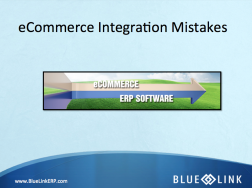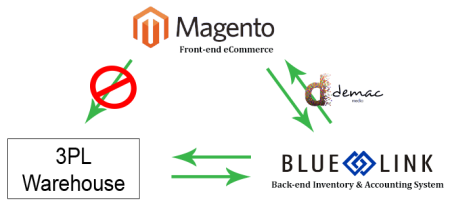Guest post by Samantha Hornby
My colleague, David Silva, and I recently presented at Demac Media’s eCommerce Meetup to discuss common eCommerce integration mistakes. Although Dave and I only presented on the most common mistakes that we see when engaged with prospects, the discussion quickly grew as others at the meetup expressed their concerns and pain points when it comes to integration. Below is a recap of some of the most common mistakes we discussed.
Mistake #1: Not Taking a Proactive Approach to Finding Proper Back-end Software
Unfortunately when it comes to developing a new eCommerce site, too many businesses have the mind set that “my current order volume is manageable, why do I need to worry about my backend system?” This type of thinking results in businesses waiting until it is almost too late to get a proper back-end inventory and accounting ERP system – when they are already struggling to fulfil orders and keep customers happy. Managing orders with an introductory system such as QuickBooks makes sense when you’re only dealing with a couple orders a day, but as your business grows, manually entering order and inventory data into multiple systems will quickly become unmanageable. This is why it is important for businesses to start thinking about getting an appropriate back-end system from day one. A realistic time frame for getting a system in place is around 2-3 months, at a minimum, plus the time it takes to evaluate vendors and make a decision. As part of your business strategy, determine how much order volume your business can adequately handle before needing a more robust system and make sure you properly prepare for the software search.
Mistake #2: Underestimating the Amount of Data Transferred Between Systems
A properly integrated system will be able to pull more than just order information down from your eCommerce store, and will also have the ability to push information up from the back-end system. Although order information is very important, there is a much more data that needs to be transferred between the back-end and front-end systems. Examples of information that you will want automatically transferred aside from orders is:
- Credit card authorization
- Customer information collected when customers place an order such as address and billing information
- Inventory availability
- Order status
- Pricing
- Product information
Mistake #3: Not Properly Integrating Multiple Systems
For businesses that use a 3rd party warehouse, a major misconception is that information can flow from the website to the warehouse bypassing the need for a back-end system. Some storefronts provide inventory capabilities, however because they are not designed for inventory management relying on these systems may lead to issues as your business grows.
The diagram above illustrates the proper flow of information between systems, with all inventory information flowing through the back-end system from the warehouse and eCommerce site. In order to make sure that all numbers are correct and accounted for the information must go through the back-end system – this will eliminate any errors from manually entering data into multiple systems. The following is an example of what can happen if the information does not flow in the above manner: An order gets placed on the eCommerce store and is immediately sent to the 3rd party warehouse and fulfilled. At the same time another order for the exact same product is placed through a different manner (called in, from Amazon/EDI, etc.), which gets entered into the back-end system. However the back-end system does not realize that the product is now out of stock because of the order that came in directly from the site. This means the customer will need to be notified that the product is not in stock and they must either wait for an order to come in or shop elsewhere.
Mistake #4: Not Treating eCommerce as a Separate Business
Trying to run an eCommerce site and distribution centre/retail store without dedicating staff to the eCommerce business will result in employees prioritizing one over the other, so it is imperative that you treat eCommerce as a separate business. This means that dedicated staff must be assigned to deal with orders, returns, customer service, and marketing for the eCommerce store which will vary greatly from what is currently being done in your retail store or distribution centre. Having separate inventory dedicated to each entity is important to avoid stock issues when transferring products and placing orders.
Mistake #5: Thinking You Can’t Afford a Proper Back-end System
Many eCommerce businesses (especially start-ups) don’t bother searching for a proper back-end system to integrate with their eCommerce store because they assume they won’t be able to afford such a system. Even if you start with an introductory system, as your eCommerce business grows and your order volume increases getting a proper back-end system will be necessary to remain competitive. When dealing with a tight budget there are a few ways to keep the costs of getting a proper ERP system down:
- Choosing a Cloud/Hosted Solution will reduce the upfront investment necessary to get a system up and running.
- Financing. As with any significant capital investment, financing or payment options are often available. When deciding on a system, speak with software vendors to determine if deals can be worked out to reduce the initial expenditure so that your company can get on the proper system to accommodate growth.
- Reduced Data Migration. Start-up companies will have less data to migrate into a new system reducing costs. Businesses that have been around for a little bit longer can prioritize the data that needs to be transferred.
- Having a Proper Mindset. Implementing a proper back-end software system for your business can be an expensive undertaking. It is crucial, however, to understand the importance of such an investment and to treat it like an acquisition of any other significant business asset – such as a truck, person, machine or piece of equipment. Software that saves you from hiring one or more people very quickly pays for itself.
eCommerce and ERP software integration is a very important aspect to consider when starting an eCommerce site. Using multiple introductory systems to manage accounting and inventory may be fine as a small business with few orders, but not looking for an appropriate system as you grow can cause many issues in the future. View the eCommerce Integration presentation.











